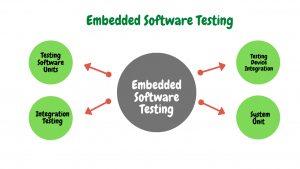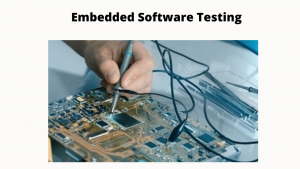Softwaretest embedded systems
What is softwaretest embedded systems ?
softwaretest embedded systems is profession involved in testing embedded devices. Either manually or automatically.
Does your project need softwaretest embedded systems. Get in touch with us we can help with your project requirements.
Software Testing is the serious phase of application development. Firstly, collect specifications and then evaluate those conditions. High-level design is produced and built and then eventually the testing process begins. Unit testing is currently carried out and then implementation and device testing is conducted. In unique and changing technologies such as cell phones, video devices, cars, aeroplanes and pharmaceutical products respectively., Embedded Software often is published. The main differences among embedded software and simple software have to be recognised immediately. The first problem is that the end user considers embedded software less noticeable. There are fairly few client implementations. A console-based software or a basic command prompt may exist. The inter – device frameworks, on the other hand, are just too deep and varied, including high-level software APIs, communication protocols, command and other protocols, etc. Hardware dependence is the next main distinction. Embedded software is intimately connected to the hardware.

Figure. 1
How to perform Embedded Software Testing?
Types of embedded Device Testing
Basically, there really are 5 test stages that can be extended to embedded applications.
Testing Software Units
The framework for the unit is a module or even a class. The development team, mainly the programmer, conducts unit testing which is typically conducted in a peer-review model. Events are produced depending on the requirements of the application evaluation.
Integration Testing for Implementation
It is possible to divide integration testing into different parts:
- Implementation phase of applications
- Integration checking for software / hardware.
The relationship of the hardware environment and the versions of the system is eventually checked. This may include the analysis of the relationship among external hardware and sensors built-in. Embedded software development is usually generated in conjunction with the software, with such a particular trait that reflects on the particular environment for which the software is operated. As greater classification cannot be done in a realistic environment, this creates difficulty for testing.
Checking the System Unit
The module to be evaluated has become a central platform consisting of complete software code in relation to all real-time operating system (RTOS) and platform-related components including alerts, deployment frameworks, telecommunications, etc. The Position of Control mechanism is no longer a call to a feature or select will establish, but instead a sent / got request that uses the streams of the RTOS system. To determine the capacity of the system to facilitate embedded system performance, payment details are examined. The preferred test method is grey-box testing for this dimension. Application unit testing is perhaps the responsibility of the developer or a committed process control team, dependent on the organisation.
Testing for Device Integration
Inside a master network, the component to be evaluated starts from a collection of components. A combination of network specific network topologies and RTOS, including such routing updates and RTOS incidents, are the Sources of Control and Observations (PCOs). The Digital testing may nonetheless perform the part of a node in opposition to a part.
Checking for System Validation
A module with a successful implementation or the entire embedded framework is the device to be evaluated. The aim of this final challenge is to satisfy the system requirement of an external organisation. Remember that an external object in a telecommunications network is either an individual or a computer, or even both.

Figure. 2
How to resolve the challenges in the Embedded system?
Embedded hackers can significantly slip by unseen, however in our everyday lives, they are now almost omnipotent. Embedded systems are simply driving the modern age just through our eyes, from devices and TV game controllers, to planes and cars. Embedded systems must be checked, as with every other sort of good device. The testing process is the most crucial accomplishment in the life cycle of production and it is when specifications are evaluated and assured that they are met. This process starts with unit testing, accompanied by testing process, and device testing in turn.
Dependency on Hardware
Testing is obviously a major threat although embedded software is strongly reliant on the hardware system in which it resides. Since the system architecture may not be accessible at the very start of the evaluation process, such basic operations are normally conducted without connection to the hardware platform of the device. Often operating systems and simulators serve as a solution, but there is still a great risk that they do not reflect the actual actions of the electronic system and could provide an incorrect sense of machine efficiency and compatibility, eventually leading to higher problems down the road.
Defects Can Be a Fight
During the testing process, a large ratio of machine failures can be detected. This may become a challenge because the issue can be with either the software itself but the equipment to which it is implemented, or even with a mixture of activities with both particular software and hardware. Debugging is exceptionally difficult and as such it is of the paramount importance to have both software and hardware expertise. Very often, in one hardware version, the established embedded software might function as planned, but not in another, which adds another challenge both to the assessment process and the lifespan of production.
Replication of defects is not straightforward.
Embedded devices find it more difficult to replicate errors because they require both software and hardware replication of events. This implies that any defect event must be regarded by the testing protocols at a far greater level of inspection than in a normal case. In addition, obtaining data from this reproduction study may often cause the device to be deliberately modified in order to locate the cause of said faults.
Upgrades for Mid-life
Frequent updates, such as kernel improvements, security fixes, various drivers, RTOS improvements, or even semiconductor adjustments, may be needed for embedded systems. Of course, assessing the performance of the possible areas of transition, all these developments have a direct effect on the research processes and their sophistication. The construction, development and implementation procedures must be given extra care as a preventive guide to avoid the same device condition can be detected and repeated for testing if necessary.
Automation Test
In contrast to standard software testing, embedded systems carry with them extra difficulties in terms of test automation. Automated testing of embedded systems generally involves the production of test rigs that enable not just software but also hardware functionality, despite their previously stated hardware dependence, and the usual hardware connectors with the other programs / subsystems. The creation of these test rigs allows for automated test programs that are critical to an effective testing process.
There is no question that testing embedded systems has the ability to be tougher than testing software applications. The primary cause of these problems may be the hard reliance on hardware, as testing teams may not always have exposure to both the hardware environment where the programme will work and therefore need to depend on simulation models to continue these practices. In comparison, without customised software, it can be difficult to test embedded systems, which then in effect often needs constant support of developers to work out exactly what the review process would entail if they want to find the best method and features to move it forward. Yet, despite the difficulties, testing also embarked on an even more important role in the field of embedded computing, considering its pervasive role in society.
Read more about this.